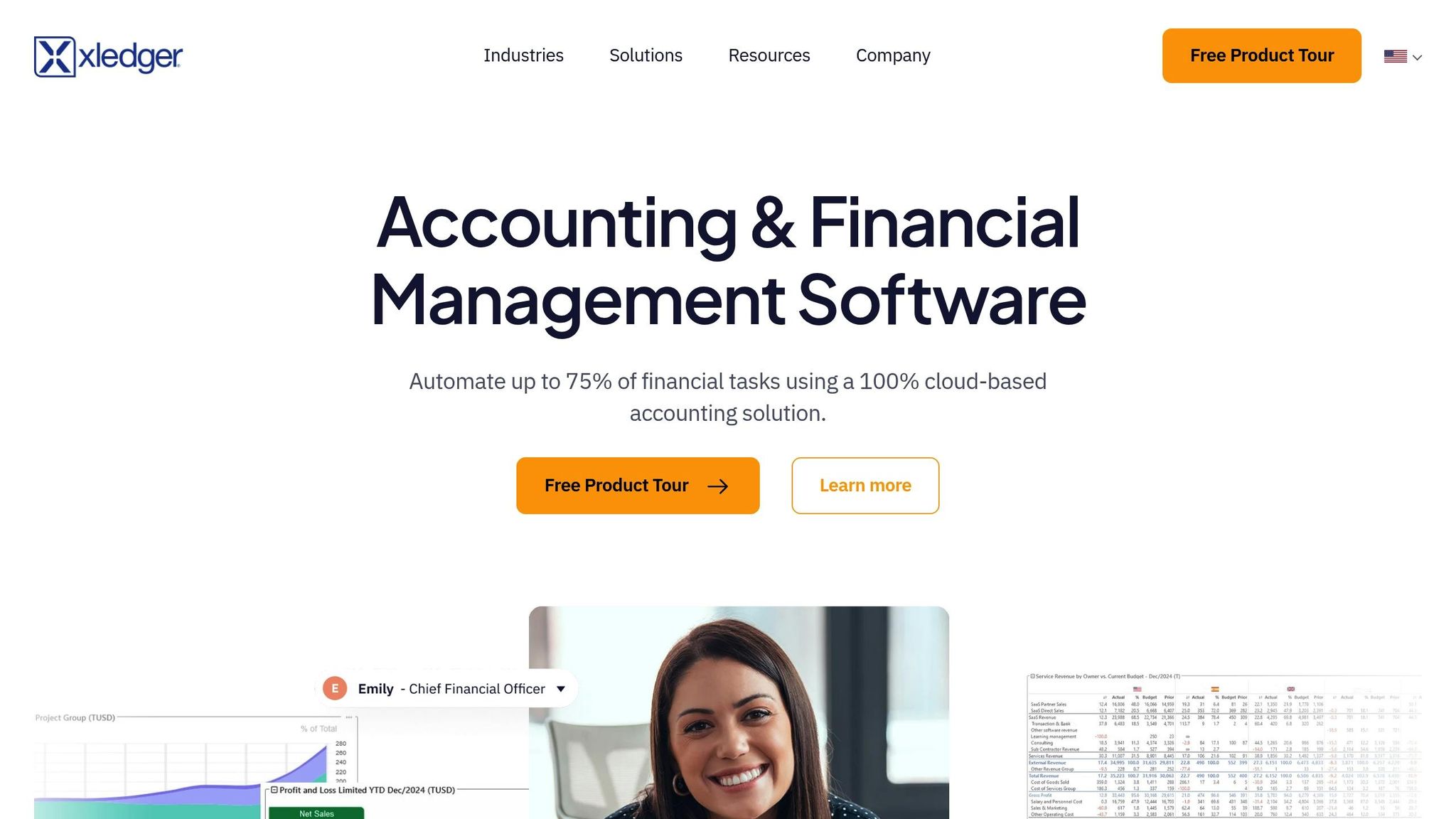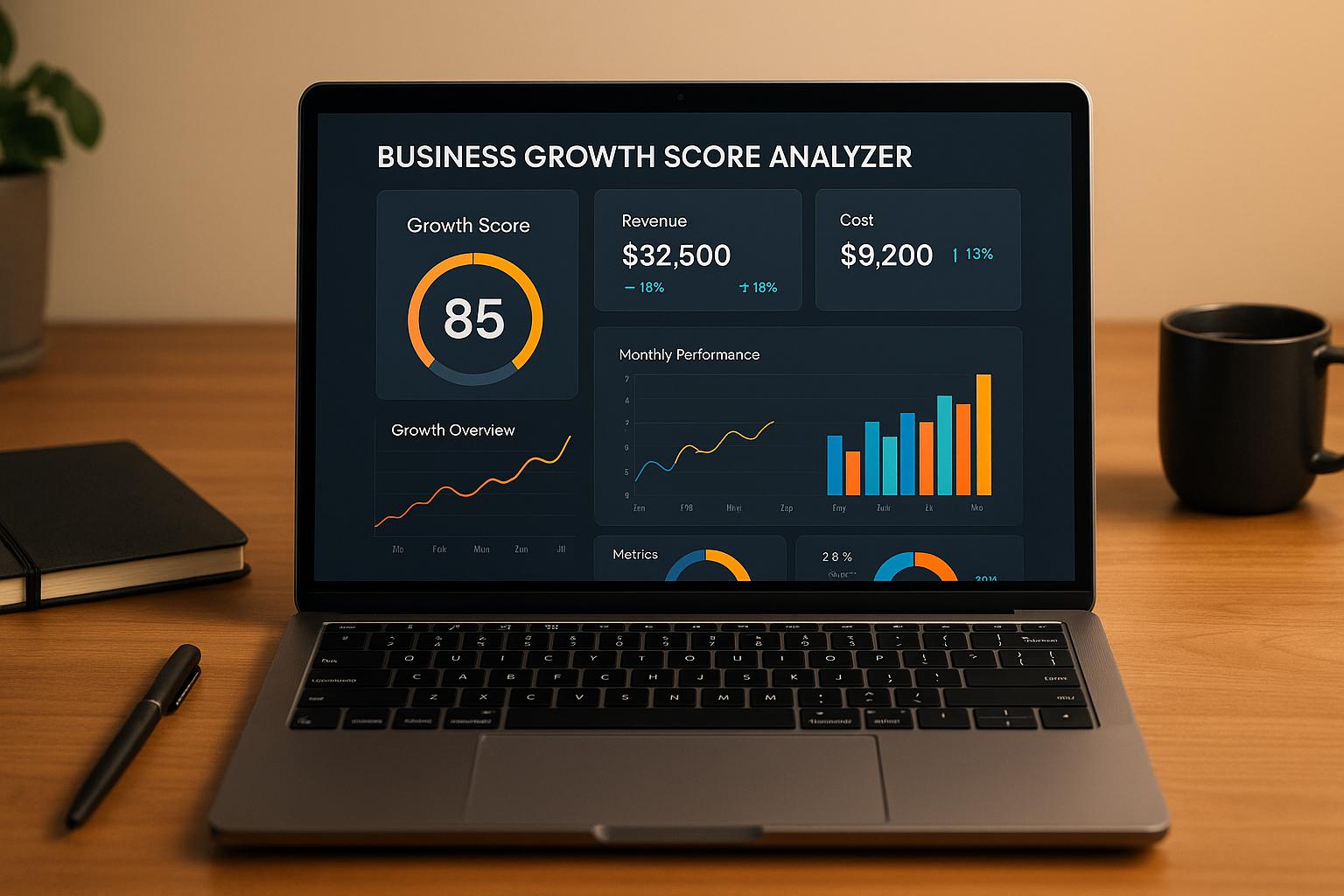How ERP Automation Improves Financial Reporting

ERP automation simplifies financial reporting by automating repetitive tasks, consolidating data, and providing real-time insights. Here's how it helps:
- Eliminates Manual Tasks: Automates data entry, reconciliation, and invoice processing, reducing errors and saving time.
- Centralizes Data: Combines financial, payroll, and operational data into one system, eliminating silos and ensuring accuracy.
- Speeds Up Month-End Closes: Cuts close times by up to 50% by automating workflows and consolidating data instantly.
- Real-Time Reporting: Provides up-to-date financial statements and dashboards for faster decision-making.
- Improves Compliance: Embeds checks and creates detailed audit trails, making compliance and audit preparation easier.
Companies using ERP automation experience faster processes, fewer errors, and better financial clarity, enabling smarter decisions and smoother operations.
Financial Reporting Software | Automated ERP | Xledger

Automating Daily Financial Tasks
Managing daily financial tasks can be a time sink for growth-stage companies. Activities like manual data entry, invoice processing, and expense tracking often create bottlenecks, slowing down reporting and increasing the likelihood of errors. ERP automation steps in to simplify these repetitive tasks, turning them into seamless, automated processes. This shift not only improves efficiency but also lays the groundwork for automating critical functions like data entry, reconciliation, payroll, and expense tracking.
Automated workflows can cut task completion time by as much as 50%, transforming processes that once took hours or days into tasks completed in minutes [7]. With this newfound efficiency, finance teams can focus more on strategic analysis and decision-making.
Automatic Data Entry and Account Matching
ERP systems take the hassle out of manual data entry by automatically pulling information from banks, credit card companies, and vendor systems. For example, when a payment is received, the system updates accounts receivable, matches the payment to the correct invoice, and reconciles it with the bank statement - all without human intervention.
Bank reconciliation, a traditionally time-consuming process, becomes significantly faster with automation. ERP systems match bank statements with accounting records automatically, completing in minutes what might take days for a manual bookkeeping team. They also flag discrepancies and send alerts for any mismatches, ensuring errors are caught and resolved quickly - well before month-end close procedures.
Invoice processing is another area where automation shines. These systems capture invoice data, match it to the appropriate documents, and schedule payments automatically, reducing delays and errors.
Phoenix Strategy Group has helped clients transition from manual processes to automated workflows, ensuring accurate data collection and reconciliation. Their approach minimizes human error while improving data accuracy and operational efficiency.
"Hire PSG if you want to make your life easier and have accurate data." - Michael Mancuso, CIO, New Law Business Model [1]
Better Payroll and Expense Tracking
Payroll and expense tracking also benefit greatly from automation. Automated payroll systems handle everything from calculations to tax withholdings and compliance requirements. They calculate federal and state taxes, generate W-2s and 1099s, and track employee expenses in line with company policies. This reduces the risk of compliance issues and simplifies the process of generating accurate reports for audits or regulatory filings.
Expense tracking becomes more streamlined and transparent. Employees can submit expenses through self-service portals, while the system routes them for approval based on company policies. It flags expenses that exceed limits, requires manager approval for specific items, and generates alerts for suspicious activity.
Real-time access to payroll and expense data empowers finance teams to make informed decisions. Instant reports on payroll costs, expense patterns, and budget usage allow managers to adjust staffing, spending, and resource allocation as needed. This level of visibility also helps organizations respond quickly to unexpected financial changes.
Automated systems also create detailed audit trails, documenting every payroll and expense transaction with timestamps, approvals, and supporting materials. This eliminates the need for manual paper trail reconstruction during audits or compliance reviews.
Additionally, automated expense tracking helps deter fraud. By enforcing company policies at the time of entry and maintaining detailed logs, the system identifies suspicious patterns or violations and triggers alerts, enabling finance teams to act quickly.
Phoenix Strategy Group integrates automated payroll processing and GAAP compliance into their bookkeeping and accounting services. Their solutions help growth-stage companies maintain accuracy and efficiency while scaling operations, ensuring routine financial tasks run smoothly without constant oversight from internal teams.
Bringing All Financial Data Together
Growth-stage companies often struggle with scattered financial data spread across various departments and systems. For instance, sales data might live in one platform, payroll details in another, and accounting records somewhere else entirely. This disjointed setup can lead to errors, duplicate entries, and a lack of clarity about the company's overall financial health.
According to Gartner, fragmented data can cost companies millions each year due to flawed analysis and poor decision-making [2]. ERP automation tackles this issue by pulling all financial data into a single, unified system. This integration eliminates departmental silos, ensuring consistency and enabling more accurate, real-time financial insights.
"The failures always happen because - finance and revenue teams working in silos. So we created what we wished we had: one unified team of finance and revenue experts delivering measurable results every week." - Phoenix Strategy Group [1]
Building One Complete Data Source
ERP systems act as a central hub for financial data across all departments. Picture this: when the sales team closes a deal, the system immediately updates revenue records, adjusts inventory, and triggers billing - all without manual intervention. Similarly, payroll data seamlessly integrates into expense reports and cash flow projections.
ETL pipelines play a critical role by standardizing and organizing disparate data. For example, when an order is processed, the ERP system updates sales, inventory, production schedules, and accounts receivable simultaneously, keeping everything in sync in real time.
By consolidating financial, sales, marketing, and general business data into a unified data warehouse, ERP systems drastically reduce the need for manual reconciliation. This frees up finance teams to focus on deeper analysis and strategic initiatives rather than chasing down mismatched numbers.
Phoenix Strategy Group specializes in helping growth-stage companies organize and clean their existing data before implementing systems that streamline collection and processing. Their approach ensures businesses are set up for efficient and reliable data management.
Better Data Accuracy and Reliability
Automated validation tools built into ERP systems cross-check entries, flag inconsistencies, and ensure only verified data makes it into financial reports. This process enhances both the accuracy and timeliness of the data.
Standardized data flows further reduce discrepancies. For instance, when a customer payment is recorded in the sales system, it automatically reflects in the accounting records in the same format. This eliminates errors caused by inconsistent data entry practices.
Real-time synchronization ensures that reports are always current. Companies with real-time data access are twice as likely to achieve better financial outcomes [2]. This immediate access allows finance teams to spot trends, address issues, and make timely adjustments before problems escalate.
Additionally, ERP systems provide detailed audit trails for every transaction, complete with timestamps, user information, and supporting documentation. These trails not only improve data reliability but also simplify compliance reporting and audit preparation.
"When you put the Right Data in front of an Empowered Team, they get better." - Phoenix Strategy Group [1]
Faster Financial Close and Report Creation
Closing the books at the end of the month often feels like a marathon, stretching out over several days. ERP automation changes the game by streamlining data consolidation, reconciliation, and transaction matching - cutting close times by up to 50% [5]. How? By automating workflows that handle these processes, freeing up time and reducing errors. This not only speeds up the month-end close but also sets the stage for smoother financial reporting.
Shorter Month-End Close Times
ERP systems tackle the common roadblocks that slow down traditional closing processes. Instead of waiting for departments to manually submit data or reconcile discrepancies, automated workflows gather and consolidate information from all sources, flagging any inconsistencies in real time.
Take the example of a mid-sized manufacturing company that swapped out its spreadsheet-based system for ERP automation. By automating account reconciliations and integrating data from sales, inventory, and payroll systems, the company slashed its month-end close time from 10 days to just 3 days [5][6]. On top of that, error rates in financial statements dropped by as much as 70% [8]. This kind of improvement is a game-changer for organizations looking to save time and reduce mistakes.
Instant Financial Statement Creation
Modern ERP systems make financial reporting almost effortless. They integrate data in real time, so balance sheets, income statements, and cash flow reports are always up to date and ready to go.
These systems come with tools like automated report generation and customizable dashboards. They pull data from multiple sources, run the necessary calculations, and generate accurate financial statements without requiring manual input [5][6][9]. This means finance teams can create reports for board meetings, investor updates, or strategic planning sessions in minutes rather than days. The ability to produce instant reports not only saves time but also supports real-time decision-making.
This feature is particularly valuable for growth-stage companies needing frequent financial updates to secure funding, manage investor relations, or make quick expansion decisions. With fast and accurate reporting, ERP automation provides the financial clarity essential for navigating these critical stages.
Phoenix Strategy Group helps businesses implement these automated financial close processes by first organizing existing data and then building systems to collect and process information efficiently. Their approach ensures companies can produce precise financial statements quickly, all while maintaining the necessary controls for strategic decision-making.
sbb-itb-e766981
Real-Time Financial Data Access
Automation might speed up month-end closings, but real-time financial data takes things a step further by enabling continuous financial oversight. With this immediate visibility, finance teams can shift their energy from tedious data collection to more impactful tasks like strategic analysis and planning.
This capability is powered by a mix of cloud computing, APIs, and automated data synchronization, which ensures that financial data stays up-to-date across all areas of a business [3]. For instance, when a sale is finalized or an expense is logged, the information flows directly into a centralized system, instantly updating reports and dashboards.
Using Dashboards for Clear Insights
Modern ERP dashboards simplify complex financial data, presenting it in a way that's easy to digest. These dashboards can display key metrics like cash flow trends, accounts receivable aging, expense categories, and revenue performance - all formatted with U.S.-specific standards, such as dollar amounts, MM/DD/YYYY dates, and familiar number formatting.
The real strength of these dashboards lies in their flexibility. Finance teams can customize views based on who needs the data. For example, a CFO might track cash flow projections and budget variances, while department heads focus on their specific expense areas and performance targets.
A 2023 case study highlighted the efficiency gains of using ERP-integrated reporting tools, showing a 50% improvement in financial reporting workflows compared to manual methods. These tools allow instant data retrieval from ERP systems and general ledgers, enabling users to update financial statements or board presentations in seconds rather than hours [7].
Another key feature is drill-down functionality, where users can click on summary figures to see the detailed transactions behind them. Export options ensure the data remains formatted for U.S. standards, making it easy to share with banks, investors, or board members. With these tools, finance teams can quickly turn raw data into actionable insights.
Making Faster Business Decisions
With clear, real-time data at their fingertips, businesses can react faster to changes, eliminating delays between events and decision-making. Leaders gain the ability to respond instantly to shifts in cash flow, spot spending trends, and seize emerging opportunities without waiting for end-of-month reports.
For example, when a large customer payment is processed, managers can immediately see the improved cash position and decide on pending investments. Similarly, if a specific expense category suddenly spikes, department heads are alerted, prompting them to investigate right away.
This agility is especially critical for growth-stage companies navigating funding rounds or planning expansions. With continuously updated data, finance teams can refine forecasts weekly, adapting strategies based on real-time performance rather than outdated projections [1].
Phoenix Strategy Group exemplifies how to leverage real-time data for smarter decisions. They implement systems that transform financial information into actionable insights, bringing finance and revenue teams together under one unified platform. This eliminates silos, speeding up decision-making.
"When you put the Right Data in front of an Empowered Team, they get better." - Phoenix Strategy Group
The competitive edge is undeniable. Companies relying on manual processes might take days to assess their financial position after a major event. In contrast, those with real-time ERP access can evaluate and act within hours - often turning potential opportunities into tangible gains while others are still catching up.
Better Compliance and Audit Preparation
Compliance violations can lead to hefty fines and legal challenges[2], but ERP automation makes managing compliance far more straightforward. By embedding compliance checks directly into daily workflows, these systems identify potential issues before they become costly problems. This proactive approach is especially valuable for growing companies preparing for funding rounds or exits, where clean and accurate financial records are a must.
The move from reactive compliance to continuous monitoring has reshaped how finance teams work. Instead of scrambling to gather documents during audit season, automated systems ensure compliance is maintained throughout the year. This not only prevents compliance headaches but also builds trust with investors, auditors, and regulators by creating a reliable, transparent foundation.
Built-In Compliance Monitoring
Modern ERP systems automate compliance monitoring, ensuring that every transaction aligns with regulatory standards. These systems validate transactions in real time, handle tax calculations automatically, and generate regulatory reports without manual effort[5]. For instance, when processing payroll, the system applies current tax rates and deduction limits automatically, flagging any discrepancies on the spot.
They also enforce controls like duty segregation and automated approval workflows. Transactions outside policy limits or requiring special approval are flagged, ensuring that only authorized personnel can approve significant payments. Any exceptions or overrides are logged and flagged for review[7][5]. This creates multiple safeguards against unauthorized transactions, while keeping detailed records of who approved what and when, ensuring all activities are well-documented and compliant[5].
Additionally, these systems detect duplicate payments and send alerts for unauthorized changes, helping businesses adhere to both internal policies and external regulations[5][3]. For example, if a payment duplicates an existing one, the system immediately notifies the finance team, preventing errors and potential fraud.
Clear Audit Records
Automated systems also excel at creating transparent audit trails. Every change is logged with details like user, timestamp, and what was altered[7][5]. This makes it easy for auditors to review records, significantly cutting down audit preparation time. If an auditor needs to trace the origin of a journal entry, the ERP system can instantly provide a detailed log of all related actions.
Consider a mid-sized manufacturing company that reduced its audit preparation time by 40% after adopting ERP automation[7]. The system’s comprehensive audit trails and standardized documentation allowed auditors to access necessary records instantly, minimizing disruptions to daily operations while ensuring full transparency[7][4].
These systems go beyond simple transaction logs. They organize financial documents in a way that clearly demonstrates regulatory compliance, keeping detailed records of every step in the financial close process[4][2]. This thorough documentation simplifies audits by providing exactly what auditors need in the format they expect.
With these tools in place, companies can stay audit-ready year-round. Phoenix Strategy Group, for example, uses ERP automation to support businesses in maintaining compliance and audit-ready financial records. Their expertise ensures that ERP systems are configured to meet regulatory requirements while supporting growth objectives. By implementing detailed audit trails and compliance workflows, they help companies avoid the last-minute scramble that often accompanies audit season.
"Hire PSG if you want to make your life easier and have accurate data." - Michael Mancuso, CIO, New Law Business Model
The benefits extend beyond just audit efficiency. Automated audit records also make responding to investor due diligence requests faster and smoother. When potential investors or acquirers request financial documentation, these systems provide instant access to properly formatted, compliant records - instilling confidence in the organization’s financial management.
Conclusion: Getting the Most from ERP Automation in Financial Reporting
ERP automation transforms the often time-consuming process of financial reporting into a powerful tool for strategic growth. Companies experience shorter close times and fewer manual tasks [5][6], while also benefiting from a marked reduction in errors [3][8]. This shift allows finance teams to dedicate more energy to strategic analysis rather than being bogged down by repetitive data collection.
Beyond streamlining operations, real-time financial data offers a critical advantage. With instant access to metrics like cash flow, expenses, and revenue, executives can make quicker, well-informed decisions. This agility is especially crucial for growth-stage companies aiming to secure funding or navigate exits [3][5][6].
To unlock these advantages, a thoughtful implementation process is key. This means choosing an ERP system that complies with U.S. regulations, ensuring smooth data migration, providing proper staff training, and leveraging expert support [3][5][6].
Phoenix Strategy Group exemplifies how expert advisory services elevate ERP automation efforts. With experience supporting over 240 portfolio companies and facilitating more than 100 mergers and acquisitions [1], they specialize in tailoring ERP systems to meet both immediate needs and long-term objectives. Their approach goes beyond basic setup, focusing on creating unified finance and revenue operations to eliminate data silos and promote seamless workflows.
"As our fractional CFO, they accomplished more in six months than our last two full-time CFOs combined. If you're looking for unparalleled financial strategy and integration, hiring PSG is one of the best decisions you can make." - David Darmstandler, Co-CEO, DataPath [1]
Key performance indicators such as reporting cycle time, error rates, and labor cost reductions [2][3][5] highlight the measurable benefits of ERP automation. Companies that approach implementation strategically - backed by expert guidance and continuous optimization - often see significant improvements in these areas.
FAQs
How does ERP automation help ensure compliance with financial regulations and streamline audits?
ERP automation helps maintain compliance by streamlining financial processes and ensuring accurate, up-to-date data recording. By automating these tasks, the chances of human error are significantly reduced, which means your financial reports consistently meet regulatory standards and are always ready for audits.
On top of that, ERP systems come equipped with features like change tracking, detailed audit trails, and secure access controls for sensitive information. These tools not only make audits easier but also showcase transparency and accountability to your stakeholders.
How does real-time financial data access through ERP systems benefit growth-stage companies?
Real-time access to financial data through ERP systems brings major benefits for companies in their growth phase. By automating the collection and reporting of financial information, ERP systems ensure that data remains current and accurate, cutting down on manual errors and streamlining operations.
Having instant access to reliable financial data empowers businesses to make quicker, well-informed decisions - whether it's evaluating cash flow, monitoring expenses, or getting ready for funding opportunities. Plus, the increased efficiency frees up teams to concentrate on strategic growth efforts instead of being bogged down by tedious administrative work.
How does ERP automation enhance payroll and expense tracking accuracy and efficiency?
ERP automation takes the hassle out of payroll and expense tracking by cutting down on manual data entry, reducing errors, and keeping everything updated in real time. These systems can handle salary calculations, deductions, and reimbursements with precision, all while staying compliant with tax laws and regulations.
Another advantage? You can centralize your payroll and expense data on one platform. This makes generating detailed reports and monitoring spending trends a breeze. The result? You save time and gain a clearer view of your financial operations, helping you make smarter, more informed decisions.



